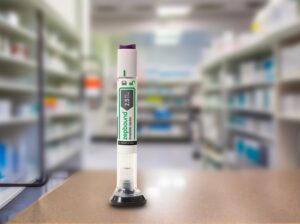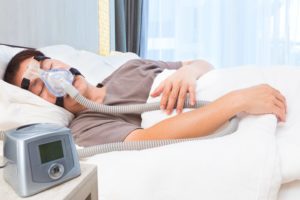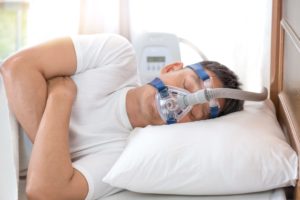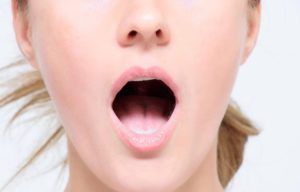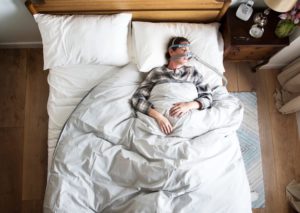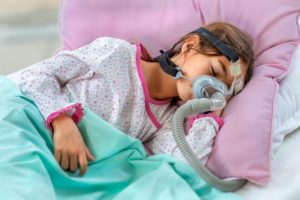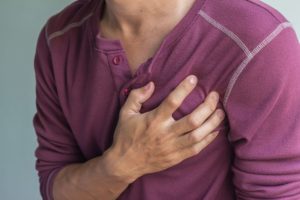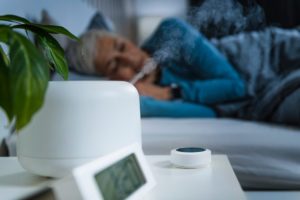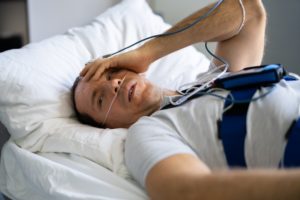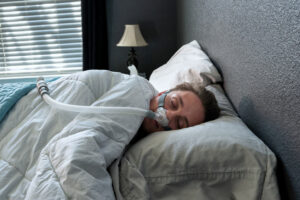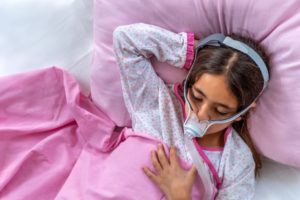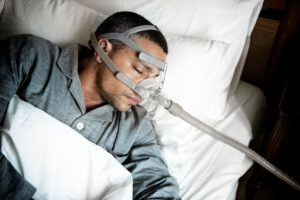When you buy through our links, we may earn a commission. Products or services may be offered by an affiliated entity. Learn more.
Paroxysmal Nocturnal Dyspnea
Experiencing shortness of breath every now and then is normal, such as after heavy exercise or physical exertion. However, this symptom should be looked into when it happens at atypical times, like in the middle of the night. If shortness of breath happens regularly and suddenly during sleep, it could be paroxysmal nocturnal dyspnea, a symptom associated with underlying health conditions like heart failure or chronic obstructive pulmonary disorder (COPD).
What Is Paroxysmal Nocturnal Dyspnea?
Paroxysmal nocturnal dyspnea (PND) describes a shortness of breath during sleep that comes on suddenly, causing the person to wake up gasping. PND typically occurs one to two hours after a person initially falls asleep. It differs from general dyspnea, or shortness of breath, which can occur at any time during the day. Although it is normal to experience daytime dyspnea occasionally, such as after intense exercise, PND is considered abnormal and could be a sign of a health condition.
Think You May Have Sleep Apnea? Get Help Today

our partner at sleepdoctor.com
10% off Home Sleep Tests
Buy Now“Truly grateful for this home sleep test. Fair pricing and improved my sleep!”
Dawn G. – Verified Tester
Paroxysmal Nocturnal Dyspnea vs. Orthopnea
Paroxysmal nocturnal dyspnea (PND) and orthopnea both describe a shortness of breath. However, PND occurs a few hours after a person falls asleep, while orthopnea can occur anytime a person is lying down, even if they are awake. Like PND, the shortness of breath associated with orthopnea normally improves once a person stands or sits up. Experienced together, they are considered diagnostic symptoms of heart failure .
Orthopnea occurs due to a buildup of fluid in the lungs when a person lies down and is a symptom of heart failure. PND also commonly occurs with heart failure, but it is associated with other conditions as well.
Paroxysmal Nocturnal Dyspnea vs. Sleep Apnea
Sleep apnea is a sleep-related breathing disorder that causes a person to experience multiple pauses in breathing or episodes of shallow breathing during sleep. Those with sleep apnea may present with PND , causing disrupted sleep and nighttime awakenings.
There are different types of sleep apnea . In obstructive sleep apnea (OSA), an obstruction or narrowing of the upper airway interrupts breathing. In central sleep apnea (CSA), there is a misfire between the brain and respiratory muscles, which leads to slower, more shallow breathing. PND can occur with either OSA or CSA, but it can also be caused by other conditions.
Symptoms
Paroxysmal nocturnal dyspnea (PND) is itself a symptom of heart failure, although it can be associated with other conditions. PND is characterized by a sudden shortness of breath that comes on soon after initially falling asleep, which can be frightening and distressing. The person wakes up gasping or coughing and may sit or stand up to try to breathe better. Another sign of PND can be a tendency to prop yourself up with pillows before sleeping, in order to avoid shortness of breath during sleep.
Causes
Nearly 90% of cases of dyspnea stem from a respiratory or cardiac condition. Potential causes of PND include:
- Asthma
- Chronic obstructive pulmonary disorder (COPD)
- Heart failure
- Pneumonia
- Psychogenic disorder
- Pulmonary edema
- Sleep apnea
Asthma
Asthma symptoms often worsen at night . If a person’s lungs become congested with fluid, they may experience an asthma attack and experience PND. People with severe asthma can also be more likely to have obstructive sleep apnea, which may increase their risk of PND .
Heart Failure
PND is strongly associated with congestive heart failure, a condition that affects around 2% of Americans .
When people lie down, blood from other parts of their body travels to the lungs. In people with healthy hearts, the heart pumps as needed to redistribute the blood back throughout the body. In people with heart failure, however, the heart cannot do this as effectively, leading to fluid buildup in the lungs and shortness of breath during sleep or when lying down. People with heart failure also have higher levels of renin , an enzyme that makes the body retain fluid.
Chronic Obstructive Pulmonary Disorder (COPD)
PND can be a sign of chronic obstructive pulmonary disease (COPD). COPD is a lung disease that makes it harder to breathe over time. Tobacco smoke, whether inhaled directly or secondhand, is the most common cause of COPD.
Psychogenic Disorder
Psychogenic disorders are physical conditions that may develop as a result of anxiety. These may manifest in a person who is otherwise healthy, but feels like they cannot breathe and experiences tingling in their mouth, fingers, and toes.
Pulmonary Edema
Both PND and orthopnea, or shortness of breath while lying down, are considered common symptoms of pulmonary edema . Pulmonary edema occurs when fluid builds up in the alveoli, or air sacs, of the lungs. The condition can be brought on by heart failure or a recent heart attack.
Sleep Apnea
Sleep apnea may also be associated with PND. Up to half of people with congestive heart failure may develop a form of sleep apnea and experience PND. In people with acute decompensated heart failure, sleep apnea may increase their risk of PND.
Risks for Paroxysmal Nocturnal Dyspnea
People who are at an increased risk of a heart failure or a lung condition may be more likely to experience dyspnea, and consequently, PND. Multiple risk factors for heart failure and lung troubles exist.
Coronary Artery Disease
Experts view coronary artery disease as the leading cause of heart failure. Chest pain and shortness of breath are common symptoms of coronary artery disease.
Hypertension
Hypertension, or high blood pressure, increases a person’s risk of experiencing heart failure, especially in women. Hypertension may also hasten the progression of heart failure.
Diabetes
Type 2 diabetes also increases the risk of heart failure. Various factors may link type 2 diabetes and heart failure, including insulin resistance and changes in the coronary arteries.
Tobacco or Alcohol Use
Smoking, alcohol, and other drug use may increase the risk of PND. Smoking is the largest risk factor for chronic obstructive pulmonary disease (COPD), with 70% of people with COPD being current or former smokers. Chronic exposure to lung irritants, including air pollution or secondhand smoke, also increases the risk of COPD.
Additional Risk Factors
People aged 65 years or older are more likely to experience heart failure. High cholesterol and obesity are also associated with an increased risk of heart failure, along with other heart failure risk factors, such as diabetes and hypertension . The risk of heart failure is also increased among people with a previous heart condition or family history of heart conditions.
Diagnosis
To understand what is causing PND, a doctor asks about symptoms and medical history. They also conduct a physical examination to look for signs of swelling, check blood pressure and weight, and listen to the heart and lungs. Then they may order a number of diagnostic tests to determine the underlying cause, such as:
- Chest x-rays, MRIs, or CT scans: These can help reveal congestion in the lungs.
- Echocardiogram or cardiac ultrasound: These tests can screen for pulmonary edema.
- Electrocardiograms: This test measures the heart’s electrical activity, which is typically abnormal in people with heart disease.
- Exercise stress test: Often conducted on a treadmill, these can show how your heart responds to physical stress and exertion.
Treatments
Treatment of PND often begins with treating the underlying conditions. Oxygen therapy may be recommended for people with COPD or fluid in the lungs. Continuous positive airway pressure (CPAP) therapy may be recommended for people with sleep apnea. Surgery may be recommended in some cases of heart failure .
Medications like beta blockers, diuretics (water pills), or enzyme inhibitors may be prescribed for heart failure. People with fluid in the lungs may be prescribed diuretics or medications that can help strengthen the heart. Asthma inhalers and inhaled corticosteroids may help control asthma symptoms at night.
Lifestyle changes may also be recommended, such as exercising, quitting smoking, improving one’s diet , or losing weight.
Tips for Sleeping With Paroxysmal Nocturnal Dyspnea
Improved sleep is an important part of managing heart failure. Lifestyle changes and improved sleep hygiene may also help improve sleep quality .
Avoid Tobacco and Alcohol
People with heart failure may be encouraged to quit smoking and avoid alcohol. Tobacco and alcohol can also disrupt restful sleep . Quitting smoking may also prevent conditions like COPD.
Follow a Regular Sleep Schedule
Go to sleep and wake up at the same time every day. Create a sleep schedule that allows for at least seven hours of sleep per night.
Increase Physical Activity
Regular exercise can improve lung function, help manage heart failure symptoms, and improve sleep . Speak with your doctor about an appropriate exercise plan for you.
Improve Diet
Unhealthy diets are associated with poor lung function and sleep . Try a Mediterranean diet largely composed of fruits, vegetables, beans, nuts, and extra virgin olive oil, with a moderate amount of fish and seafood. Lower salt intake may also be recommended for people with heart failure.
Elevate the Chest During Sleep
For certain lung conditions, the doctor may recommend elevating the chest during sleep by bunching up pillows or using an adjustable mattress.
When to Talk to Your Doctor
While paroxysmal nocturnal dyspnea (PND) does not always signal a serious health condition, it is an important symptom that should be addressed. If you notice signs of PND and wake up gasping for air, make an appointment with your doctor. If your breathing does not return to normal or you notice other symptoms, like rapid breathing or an irregular heartbeat, call 9-1-1.

Still have questions? Ask our community!
Join our Sleep Care Community — a trusted hub of sleep health professionals, product specialists, and people just like you. Whether you need expert sleep advice for your insomnia or you’re searching for the perfect mattress, we’ve got you covered. Get personalized guidance from the experts who know sleep best.
References
19 Sources
-
Ekundayo, O. J., Howard, V. J., Safford, M. M., McClure, L. A., Arnett, D., Allman, R. M., Howard, G., & Ahmed, A. (2009). Value of orthopnea, paroxysmal nocturnal dyspnea, and medications in prospective population studies of incident heart failure. The American Journal of Cardiology, 104(2), 259–264.
https://pubmed.ncbi.nlm.nih.gov/19576357/ -
Slowik, J. M., & Collen, J. F. (2022). Obstructive sleep apnea. In StatPearls. StatPearls Publishing.
https://pubmed.ncbi.nlm.nih.gov/29083619/ -
Kimoff, R. J. (2015). When to suspect sleep apnea and what to do about it. The Canadian Journal of Cardiology, 31(7), 945–948.
https://pubmed.ncbi.nlm.nih.gov/26112305/ -
Strohl, K. P. (2019, March). Merck Manual Consumer Version: Sleep Apnea., Retrieved March 25, 2022, from
https://www.merckmanuals.com/home/lung-and-airway-disorders/sleep-apnea/sleep-apnea -
Rials, S. J., Hatlestad, J. D., Smith, A., Pubbi, D., Slotwiner, D. J., & Boehmer, J. P. (2017). Night-time elevation angle in heart failure patients indicates orthopnea and paroxysmal nocturnal dyspnea. Journal of Cardiac Failure, 23(8), S81.
https://www.onlinejcf.com/article/S1071-9164(17)30451-7/fulltext -
Greenberg, H., & Cohen, R. I. (2012). Nocturnal asthma. Current Opinion in Pulmonary Medicine, 18(1), 57–62.
https://pubmed.ncbi.nlm.nih.gov/22045347/ -
Yagishita-Tagawa, Y., Yumino, D., Takagi, A., Serizawa, N., & Hagiwara, N. (2013). Association between sleep apnea and overnight hemodynamic changes in hospitalized heart failure patients with and without paroxysmal nocturnal dyspnea. Journal of Cardiology, 61(5), 348–353.
https://pubmed.ncbi.nlm.nih.gov/23507270/ -
Komanduri, S., Jadhao, Y., Guduru, S. S., Cheriyath, P., & Wert, Y. (2017). Prevalence and risk factors of heart failure in the USA: NHANES 2013 – 2014 epidemiological follow-up study. Journal of Community Hospital Internal Medicine Perspectives, 7(1), 15–20.
https://pubmed.ncbi.nlm.nih.gov/28634519/ -
Sullivan, R. D., Mehta, R. M., Tripathi, R., Reed, G. L., & Gladysheva, I. P. (2019). Renin activity in heart failure with reduced systolic function-New insights. International Journal of Molecular Sciences, 20(13), 3182.
https://pubmed.ncbi.nlm.nih.gov/31261774/ -
National Heart, Lung, and Blood Institute. (2022, March 24). What is COPD?., Retrieved March 10, 2022, from
https://www.nhlbi.nih.gov/health-topics/copd -
A.D.A.M. Medical Encyclopedia. (2019, July 15). Pulmonary edema. MedlinePlus., Retrieved March 10, 2022, from
https://medlineplus.gov/ency/article/000140.htm -
Paudel, R., Beridze, N., Aronow, W. S., Ahn, C., Sanaani, A., Agarwal, P., Farell, K., Jain, D., Timmermans, R., Cooper, H. A., & Panza, J. A. (2016). Association of chest pain versus dyspnea as presenting symptom for coronary angiography with demographics, coronary anatomy, and 2-year mortality. Archives of Medical Science, 12(4), 742–746.
https://pubmed.ncbi.nlm.nih.gov/27478454/ -
Jiang, S. Z., Lu, W., Zong, X. F., Ruan, H. Y., & Liu, Y. (2016). Obesity and hypertension. Experimental and Therapeutic Medicine, 12(4), 2395–2399.
https://pubmed.ncbi.nlm.nih.gov/27703502/ -
National Heart, Lung, and Blood Institute. (2022, March 24). Heart failure: Treatment., Retrieved March 10, 2022, from
https://www.nhlbi.nih.gov/health/heart-failure/treatment -
Gutiérrez-Carrasquilla, L., Sánchez, E., Hernández, M., Polanco, D., Salas-Salvadó, J., Betriu, À., Gaeta, A. M., Carmona, P., Purroy, F., Pamplona, R., Farràs, C., López-Cano, C., Fernández, E., & Lecube, A. (2019). Effects of Mediterranean diet and physical activity on pulmonary function: A cross-sectional analysis in the ILERVAS Project. Nutrients, 11(2), 329.
https://pubmed.ncbi.nlm.nih.gov/30717453/ -
Yazdi, Z., Loukzadeh, Z., Moghaddam, P., & Jalilolghadr, S. (2016). Sleep hygiene practices and their relation to sleep quality in medical students of Qazvin University of Medical Sciences. Journal of Caring Sciences, 5(2), 153–160.
https://pubmed.ncbi.nlm.nih.gov/27354979/ -
Spadola, C. E., Guo, N., Johnson, D. A., Sofer, T., Bertisch, S. M., Jackson, C. L., Rueschman, M., Mittleman, M. A., Wilson, J. G., & Redline, S. (2019). Evening intake of alcohol, caffeine, and nicotine: Night-to-night association with sleep duration and continuity among African Americans in the Jackson Heart Sleep Study. Sleep, 42(11), zsz136.
https://pubmed.ncbi.nlm.nih.gov/31386152/ -
Kline, C. E. (2014). The bidirectional relationship between exercise and sleep: Implications for exercise adherence and sleep improvement. American Journal of Lifestyle Medicine, 8(6), 375–379.
https://pubmed.ncbi.nlm.nih.gov/25729341/ -
Zuraikat, F. M., Makarem, N., Liao, M., St-Onge, M. P., & Aggarwal, B. (2020). Measures of poor sleep quality are associated with higher energy intake and poor diet quality in a diverse sample of women from the Go Red for Women Strategically Focused Research Network. Journal of the American Heart Association, 9(4), e014587.
https://pubmed.ncbi.nlm.nih.gov/32063123/





